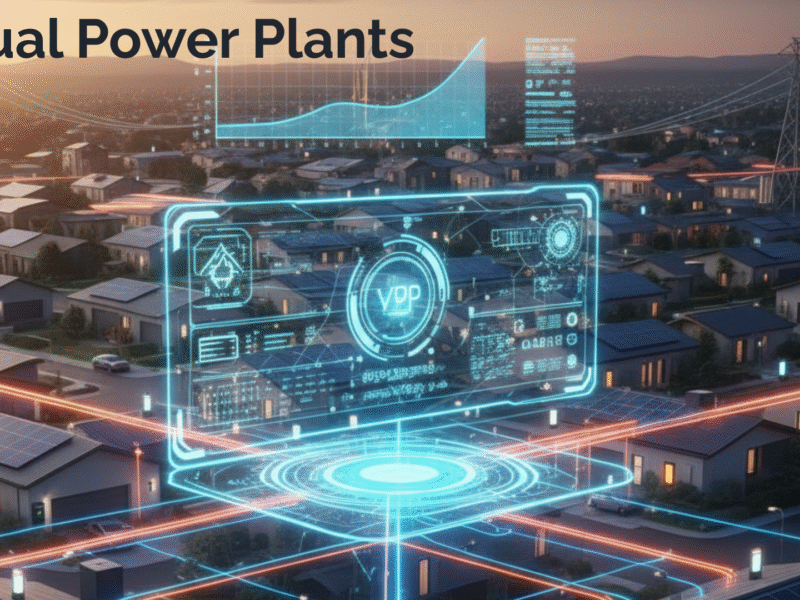
The global energy transition is moving fast. As the decentralized model dominated by solar energy takes hold, the grid needs a new operating system. That solution is the Virtual Power Plant (VPP). This technology is critical for managing the variable power flow and securing the reliable Future of solar energy. As rooftop solar panels become standard fixtures on homes and businesses worldwide, the electricity grid faces an unprecedented operational challenge: how to effectively manage, control, and utilize power that is intermittent and geographically scattered. The answer lies not in building new physical power plants, but in deploying sophisticated digital infrastructure—the Virtual Power Plant (VPP).
A VPP is, in essence, the operating system for the modern, renewable grid. It utilizes cloud-based software, Artificial Intelligence (AI), and secure communication networks to aggregate the collective power of thousands of distributed energy resources (DERs). These resources—which include home battery storage, electric vehicles (EVs), smart thermostats, and small industrial loads—act as a single, coordinated, and dispatchable resource pool. This advanced orchestration is absolutely critical for realizing the full potential and ensuring the stability of the Future of solar energy.
The Great Challenge: Unlocking the Future of Solar Energy
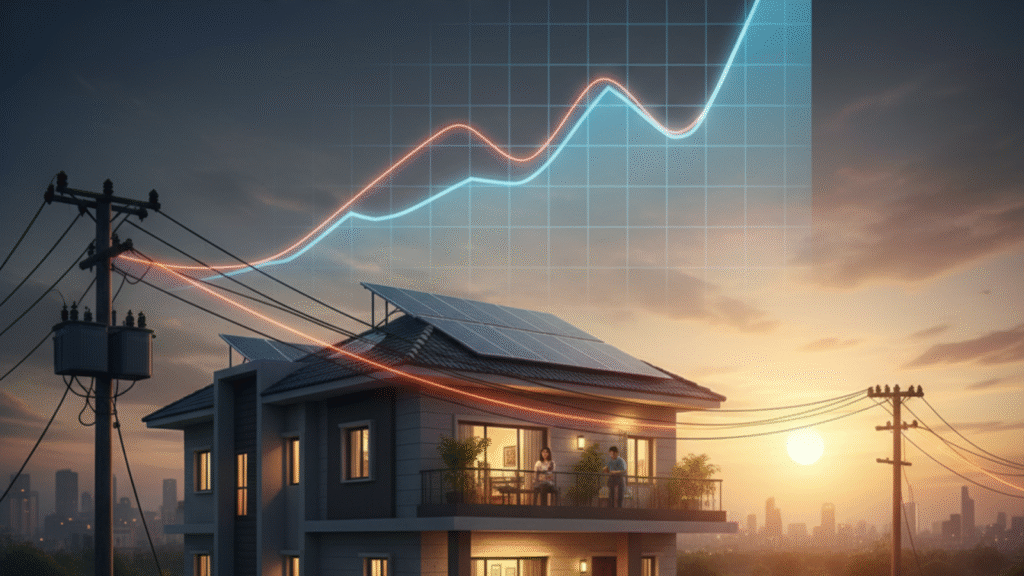
The primary hurdle to mass adoption of solar energy is its inherent variability. The sun shines brightly only during certain hours, and a passing cloud can instantly drop generation levels. This variability creates significant stress on the traditional grid structure, particularly in managing the daily energy supply and demand dynamics.
Virtual Power Plants (VPPs) and the Solution to the Duck Curve
The most vivid manifestation of solar-induced grid stress is the “Duck Curve.” This graph illustrates the net demand for electricity (total demand minus solar generation) over a typical day in a high-solar region.
- The Midday Oversupply: During the day, solar panels produce maximum power, causing net demand to dip dramatically (the belly of the duck). This can overwhelm substations and necessitates power curtailment—wasting clean, free energy.
- The Evening Ramp: When the sun sets, solar generation drops to zero in minutes, yet demand for electricity (lights, cooking, cooling) spikes simultaneously. This requires conventional power sources—often inefficient, expensive, and polluting “peaker plants”—to ramp up production extremely quickly (the steep neck of the duck).
This rapid, dramatic shift strains infrastructure and drives operational costs sky-high. VPPs solve this problem by transforming the solar output from a liability into an asset. They use coordinated battery storage to soak up the midday excess and then discharge that stored energy during the critical evening ramp, effectively flattening the Duck Curve.
Defining and Operating Virtual Power Plants (VPPs)
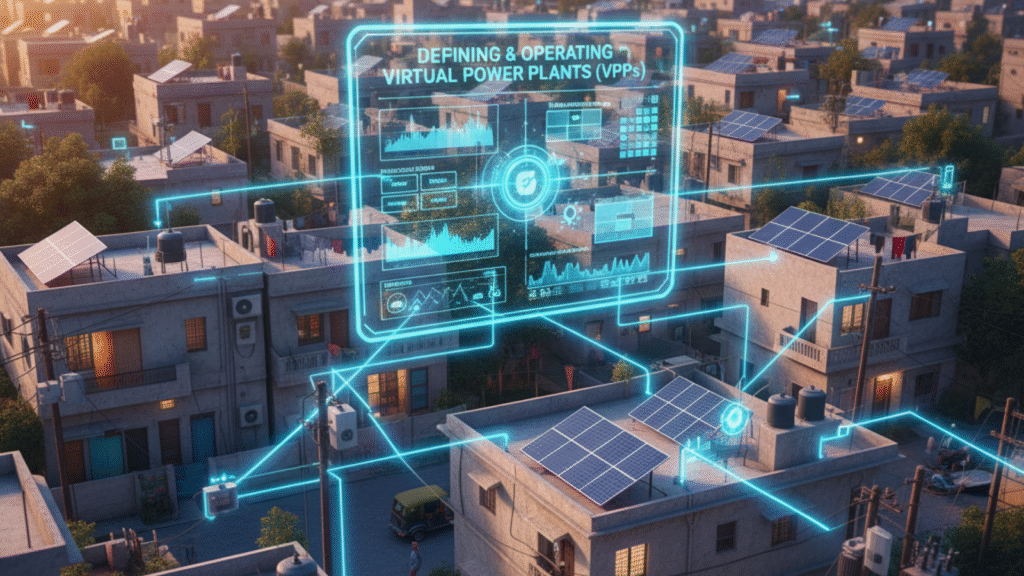
A Virtual Power Plant does not generate power itself; it controls the generation, consumption, and storage of power from assets owned by consumers and businesses. It is an intelligent management layer operating in real-time.
Core Components Driving the Future of Solar Energy
The VPP structure relies on seamless integration between various technological components:
| VPP Component | Function and Description | Impact on Grid Management |
| Distributed Energy Resources (DERs) | The physical assets: Residential and commercial solar PV, home batteries (e.g., Powerwall), controllable loads (A/C, water heaters), and EV chargers. | Provides the flexible capacity (the supply and demand leverage) necessary for grid balancing. |
| Aggregation Platform (The Brain) | Cloud-based software utilizing AI/ML for data analysis, forecasting (weather, prices, demand), and dispatch optimization. | Determines the precise, economically optimal schedule for charging or discharging every connected asset. |
| Secure Communication Network | Two-way, high-speed protocols (e.g., OpenADR) linking the central platform to local asset controllers via the internet. | Enables instantaneous command transmission, allowing VPPs to respond to grid events in milliseconds. |
| Market Integration Module | Software interface allowing the VPP to bid and transact with wholesale electricity markets (e.g., ISOs/RTOs) for energy, capacity, and ancillary services. | Generates revenue by selling VPP services, subsidizing costs for participating customers. |
VPP Services: Providing Stability with Virtual Power Plants (VPPs)
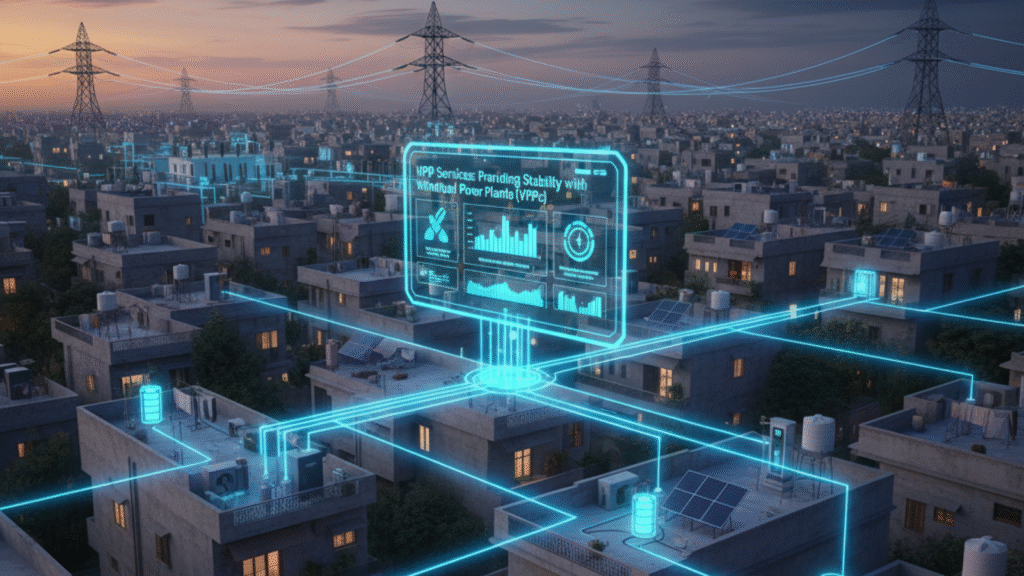
The true value of VPPs is derived from the essential grid services they can provide with precision and speed, often surpassing the performance of legacy power plants. The ability of VPPs to act as dynamic stabilizers is what guarantees the reliability of the future of solar energy.
Key Grid Stabilization Functions of a VPP
1. Peak Shaving and Load Shifting: When electricity prices and demand peak, the VPP instantly instructs thousands of batteries across its network to discharge. This collective discharge reduces the immediate need for conventional generation, shaving the peak demand. Conversely, during low-demand, high-solar hours, the VPP shifts energy consumption (or load) by prompting assets to charge or run, guaranteeing the solar power is consumed locally instead of being wasted. This dynamic control ensures optimal utilization of every solar kilowatt-hour.
2. Frequency Regulation (Ancillary Services): Grid frequency (typically 50 or 60 Hz) is a critical indicator of grid health. If generation exceeds demand, frequency rises; if demand exceeds generation, it falls. VPPs, with their rapid-response communication systems, can inject or withdraw power almost instantaneously to precisely regulate frequency. This speed and accuracy make them superior to large, slow-moving power plants, providing essential “Ancillary Services” that maintain stability.
3. Congestion Relief: In areas where local transmission lines or transformers are reaching their capacity limits, the VPP can strategically curtail power output or increase consumption in that specific area. This prevents local equipment damage and defers the need for costly, large-scale infrastructure upgrades.
4. Emergency Reserves and Black Start Capability: When the regional grid suffers a major failure, the VPP’s aggregated, decentralized storage can serve as a reliable backup reserve. Furthermore, in future implementations, these coordinated assets could potentially provide the initial power needed to restart larger power plants, contributing to a “black start” scenario and accelerating recovery after a complete blackout.
Economic Empowerment: Unlocking the Value of Solar Energy through VPP Participation
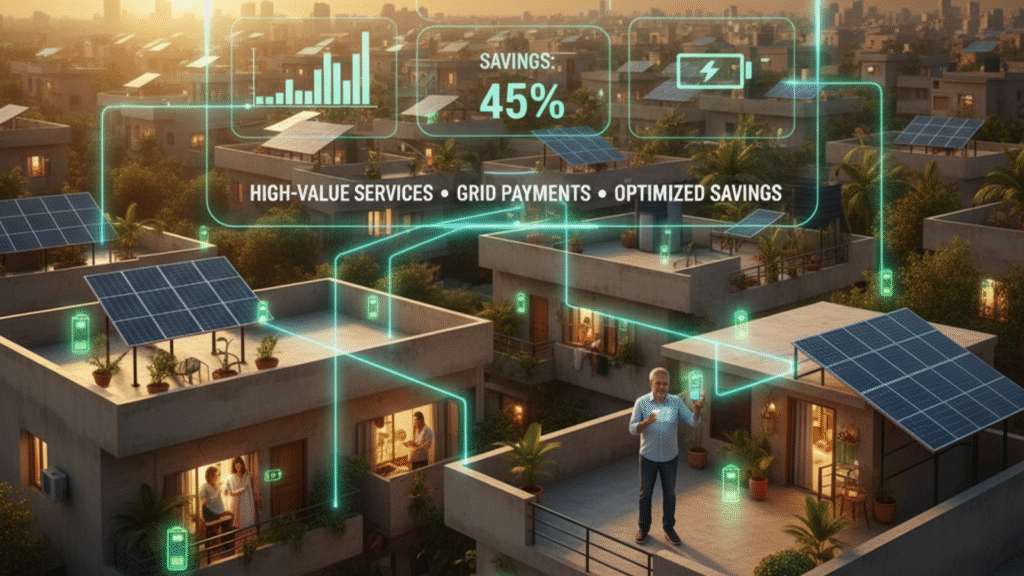
The shift to VPPs democratizes energy access and turns the homeowner from a simple consumer into an active participant—a “prosumer”—with new financial leverage. This consumer buy-in is pivotal for scaling the Future of solar energy.
The Financial Upside for VPP Members
| Economic Benefit | Description | How the VPP Facilitates It |
| Revenue Generation | Earning passive income by providing capacity and energy to the grid during high-demand or emergency periods. | Aggregates hundreds of small contributions into a viable, market-ready resource that commands high prices. |
| Optimized Bill Savings | Automatically managing charging/discharging based on variable time-of-use (TOU) tariffs or real-time pricing. | Uses AI algorithms to predict price fluctuations and schedule asset operations to minimize peak-rate purchases. |
| Incentive Payments | Receiving upfront payments or monthly credits from utility companies for enrolling the battery’s capacity into the VPP network. | Secures grid resources by signing long-term capacity contracts with the utility, paying a portion of that fee to the asset owner. |
| Maximizing Solar ROI | Ensuring every kilowatt-hour generated by rooftop solar is either used, stored, or sold at the highest possible value. | Eliminates solar curtailment and ensures zero wastage of clean energy production. |
The Role of AI and Data in the Virtual Power Plants (VPPs) Architecture
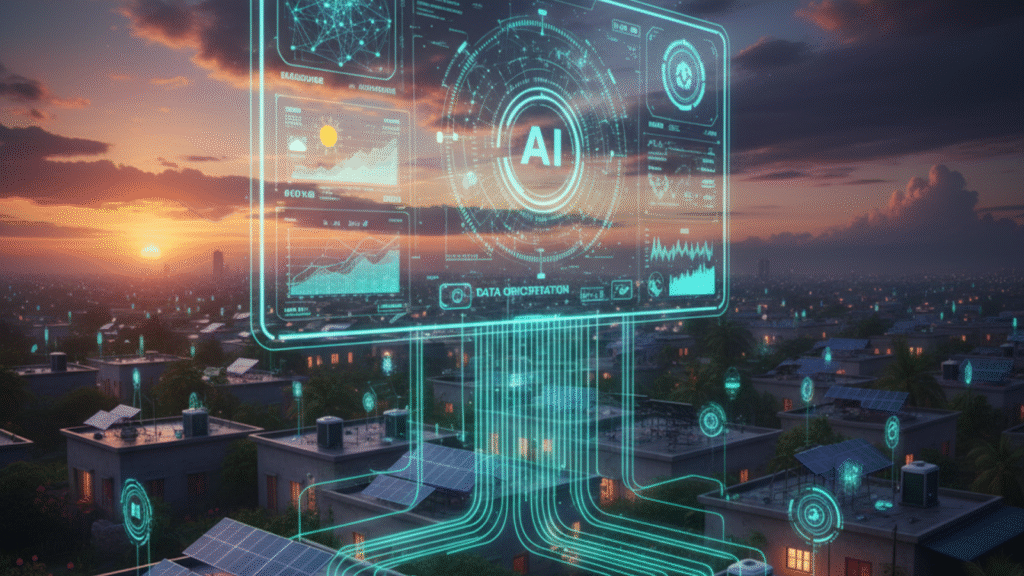
The sheer complexity of coordinating millions of devices across a vast geography, all while responding to instantaneous market and weather changes, necessitates sophisticated software. Artificial Intelligence (AI) and Machine Learning (ML) form the brain of the VPP.
AI models continuously process enormous datasets, including hyper-local weather patterns, real-time energy prices, and historical consumption data. This allows the VPP to move beyond simple automation to predictive optimization. The AI doesn’t wait for a high-price event; it anticipates it hours in advance, ensuring batteries are topped off and ready to dispatch power exactly when the market needs it most. This autonomous, forward-looking capability is the engine that drives grid efficiency and secures the economic viability of the distributed Future of solar energy.
Overcoming Regulatory Hurdles for the Future of Solar Energy’s Success
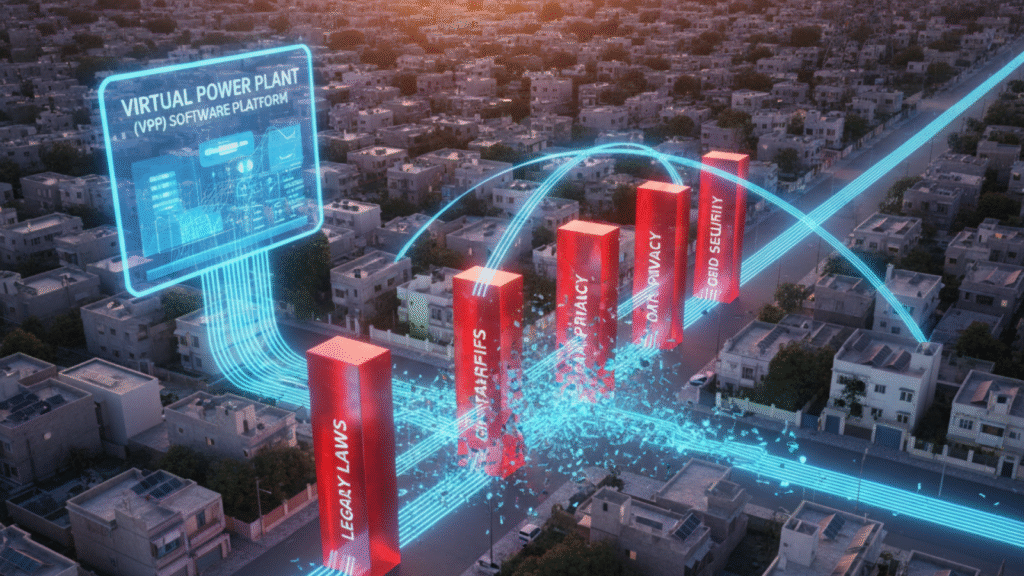
While the technology for Virtual Power Plants (VPPs) is mature, their path to ubiquity is complicated by outdated regulatory frameworks. Existing utility regulations and wholesale market rules were built around the operation of large, centralized power plants, creating systemic barriers for DERs.
Standardization and Security Challenges for Virtual Power Plants (VPPs)
Interoperability: Different manufacturers of solar inverters, batteries, and smart home devices often use proprietary communication standards. For a VPP to scale effectively, it requires standardization. Industry protocols like OpenADR (Open Automated Demand Response) are being adopted to ensure VPP software can talk to any brand of asset, facilitating seamless integration and rapid scaling.
Cybersecurity: A distributed system presents millions of potential cyber entry points. Securing the VPP requires robust, layered security measures, including end-to-end encryption for all dispatch signals and continuous monitoring of network endpoints to protect both grid integrity and customer privacy. VPP operators must ensure that optimizing the grid never compromises the security or availability of a customer’s primary power backup.
Conclusion
The evolution of the grid is inevitable, driven by the falling cost of solar energy and the consumer demand for independence. Virtual Power Plants (VPPs) are not merely an add-on; they represent the essential intelligence layer that manages this revolution. They transform intermittent, distributed solar power into a reliable, dispatchable, and highly efficient resource.
By flattening the Duck Curve, enhancing grid stability through rapid ancillary services, and financially rewarding consumers for their participation, VPPs are accelerating the transition away from fossil fuels. They are the invisible, decentralized control system that ensures the future of solar energy is not only clean but also stable, resilient, and ready to meet the demands of a modern world.
Frequently Asked Questions (FAQ)
Q1: How much money can I earn by joining a VPP with my solar and battery system?
A: Earnings vary widely based on your local market rules and your battery’s size. Compensation typically involves two parts: a monthly capacity fee for making your battery available, and performance payments each time your battery is discharged to support the grid. Annual earnings can range from hundreds to over a thousand dollars in favorable markets.
Q2: Will the VPP take all the power from my home battery?
A: No. VPPs prioritize your safety. The program always maintains a minimum reserve level (e.g., 20% to 50%) in your battery. The VPP only uses the stored energy above that guaranteed reserve, ensuring you always have backup power during an outage.
Q3: Is the term “VPP” interchangeable with “Smart Grid”?
A: No, they are related but distinct. The Smart Grid is the broad, modern electrical infrastructure. A VPP is a specific software application and business model that operates on top of the Smart Grid, using its communication capabilities to manage distributed resources (DERs).
Q4: Which assets are the most valuable to a VPP today?
A: Home battery storage systems are the most valuable assets. Unlike solar panels, which only generate power, batteries provide flexibility—the ability to absorb, store, and release energy on command. This two-way control allows the VPP to offer critical services like peak shaving and frequency regulation.
Q5: What regulatory action made VPPs possible in the United States?
A: The most significant step was the Federal Energy Regulatory Commission’s (FERC) Order 2222 (issued in 2020). This ruling required U.S. grid operators to create rules allowing distributed energy aggregations (like VPPs) to compete directly in the wholesale electricity markets.

